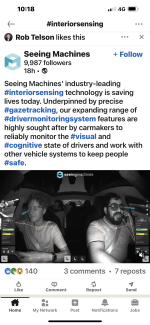Tothemoon24
Top 20
Anyone had a look at a company called
Seeing Machines
In the first half year to the end of December 2022 the group saw revenues up 54% from $15.8m to $24.4m, with an end period cash balance of $52.2m ($40.5m end June).
The net loss was reduced by 47% to $5.4m ($10.1m), while the annual recurring revenue was increased nearly 17% to $11.9m ($10.2m).
The safety focus tailwinds are boosting the expansion of the company’s addressable market, adding to the attractive structural growth drivers in the Automotive, Aftermarket and Aviation sectors.
The Business
This group has come a long way over the last 23 years, from the 1997 research work into vision-based human-machine interfaces undertaken by Volvo Technology of Sweden and researchers at the Australian National University.
That work was to develop technologies that enable computers to detect, track and interpret human faces and facial features, with the initial aim to improve driver safety.
Three years later the company was set up.
Today the group, headquartered in Australia, is a global industry leader in vision-based monitoring technology that enable machines to see, understand and assist people. Seeing Machines is revolutionising global transport safety.
Its technology portfolio of AI algorithms, embedded processing and optics, power products that need to deliver reliable real-time understanding of vehicle operators.
The technology spans the critical measurement of where a driver is looking, through to classification of their cognitive state as it applies to accident risk.
Reliable “driver state” measurement is the end-goal of Driver Monitoring Systems (DMS) technology.
Seeing Machines develops DMS technology to drive safety for Automotive, Commercial Fleet, Off-road and Aviation.
The company has offices in Australia, USA, Europe and Asia, and supplies technology solutions and services to industry leaders in each market vertical.
The group is continuing to grow as an automotive technology leader in driver and occupant monitoring system technology, having now won a total of 15 automotive programs spanning 10 individual OEMs, covering more than 160 distinct vehicle models.
The cumulative initial lifetime value of all OEM programs that Seeing Machines has won to date now stands at $321m.
The company reported a total of 701,049 cars on road as at 31 December 2022, representing an increase of 188% over the 12 months period (243,722) spanning six individual programs with four global OEMs.
Guardian, Seeing Machines’ Aftermarket driver distraction and fatigue technology, is now installed into and monitoring 46,018 individual vehicles, compared to 36,933 in December 2021 representing a 25% increase over the 12-month period.
Seeing Machines
In the first half year to the end of December 2022 the group saw revenues up 54% from $15.8m to $24.4m, with an end period cash balance of $52.2m ($40.5m end June).
The net loss was reduced by 47% to $5.4m ($10.1m), while the annual recurring revenue was increased nearly 17% to $11.9m ($10.2m).
The safety focus tailwinds are boosting the expansion of the company’s addressable market, adding to the attractive structural growth drivers in the Automotive, Aftermarket and Aviation sectors.
The Business
This group has come a long way over the last 23 years, from the 1997 research work into vision-based human-machine interfaces undertaken by Volvo Technology of Sweden and researchers at the Australian National University.
That work was to develop technologies that enable computers to detect, track and interpret human faces and facial features, with the initial aim to improve driver safety.
Three years later the company was set up.
Today the group, headquartered in Australia, is a global industry leader in vision-based monitoring technology that enable machines to see, understand and assist people. Seeing Machines is revolutionising global transport safety.
Its technology portfolio of AI algorithms, embedded processing and optics, power products that need to deliver reliable real-time understanding of vehicle operators.
The technology spans the critical measurement of where a driver is looking, through to classification of their cognitive state as it applies to accident risk.
Reliable “driver state” measurement is the end-goal of Driver Monitoring Systems (DMS) technology.
Seeing Machines develops DMS technology to drive safety for Automotive, Commercial Fleet, Off-road and Aviation.
The company has offices in Australia, USA, Europe and Asia, and supplies technology solutions and services to industry leaders in each market vertical.
The group is continuing to grow as an automotive technology leader in driver and occupant monitoring system technology, having now won a total of 15 automotive programs spanning 10 individual OEMs, covering more than 160 distinct vehicle models.
The cumulative initial lifetime value of all OEM programs that Seeing Machines has won to date now stands at $321m.
The company reported a total of 701,049 cars on road as at 31 December 2022, representing an increase of 188% over the 12 months period (243,722) spanning six individual programs with four global OEMs.
Guardian, Seeing Machines’ Aftermarket driver distraction and fatigue technology, is now installed into and monitoring 46,018 individual vehicles, compared to 36,933 in December 2021 representing a 25% increase over the 12-month period.









